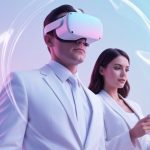

Education is one of the most important pillars of our society, but traditional teaching methods are reaching their limits in an increasingly digital world. Pupils and students today expect more than static textbooks and frontal teaching - they want to learn actively and interactively. This is exactly where Augmented Reality (AR) an.
AR extends the physical world with digital content and creates immersive learning environmentsthat visualize complex concepts, increase motivation and enrich the learning process. From virtual excursions and interactive simulations to AR-supported language learning methods - this technology opens up completely new possibilities for teachers and learners.
Augmented reality in education means supplementing physical learning materials with digital, interactive content. With the help of AR-enabled devices such as tablets, smartphones or AR glasses, pupils and students can visualize information in 3D, carry out simulations and immerse themselves in virtual environments.
For example, instead of just seeing a chemical reaction in a textbook, students can simulate the reaction in real time using an AR app. This active engagement with the subject matter promotes understanding and retention.
Virtual excursions and museum visits
AR enables students to explore the pyramids of Giza, the seabed or outer space - without leaving the classroom. Apps such as "Google Expeditions" offer immersive experiences where learners can experience history, geography or biology up close.
Interactive simulations in science and technology
Physical experiments or biological processes can be visualized and simulated using AR. In engineering courses, for example, machines or buildings can be designed and analyzed virtually before a physical model is created.
Language learning with AR-supported immersion methods
AR makes language learning more interactive and practice-oriented. Learners can use AR apps to communicate virtually with native speakers or link vocabulary to virtual objects in order to internalize it more quickly.
1. improved visualization of complex concepts
Abstract concepts such as molecular structures, historical events or mathematical formulas become more tangible with AR. This is particularly helpful in scientific subjects where visualization plays a key role.
2. active learning through interactivity
AR motivates learners to actively participate in lessons. They can interact with content independently, carry out experiments and apply their knowledge directly.
3. increased motivation and commitment
Through playful elements and immersive learning, AR becomes a means of engaging pupils and students. This is particularly effective for difficult or dry topics.
Select suitable tools and platforms
Schools and universities should rely on proven AR platforms that are suitable for their specific requirements. Examples include "Merge Cube" for 3D objects or "JigSpace" for technical simulations.
Develop content for specific subjects
The content must be aligned with the curricula. AR can be particularly useful in science, geography, history and languages.
Train teachers
The introduction of AR requires appropriate training for teachers. They need to learn how to use the technology effectively and integrate it into lessons.
Costs and access to technologies
The acquisition of AR devices and the Content development can be expensive. Educational institutions should take advantage of funding programs or collaborations with technology providers to reduce costs.
Technological infrastructure
Many schools and universities do not have the necessary infrastructure to use AR across the board. A gradual introduction and a focus on core subjects can help to overcome this hurdle.
Augmented reality is revolutionizing education by making abstract concepts tangible and motivating pupils and students through interactive experiences. From virtual excursions to scientific simulations, AR offers countless opportunities to enrich lessons and improve the learning process.
It is crucial for educational institutions to recognize the potential of AR and integrate it into the classroom. With the right technology and strategy, they can not only improve learning, but also promote the fun of discovery and understanding.

Are you interested in developing a virtual reality or 360° application? You may still have questions about budget and implementation. Feel free to contact me.
I am looking forward to you
Clarence Dadson CEO Design4real






